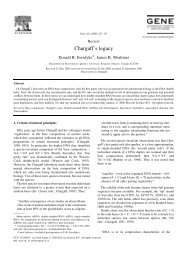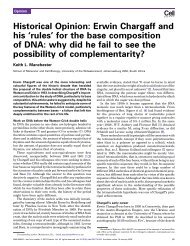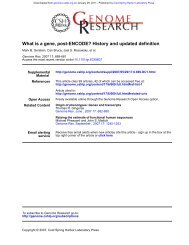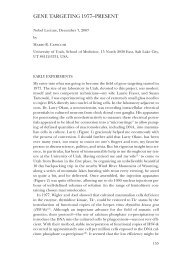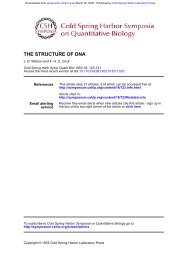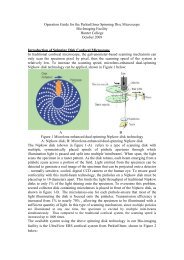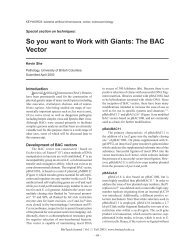Chemical specificity of nucleic acids and mechanism of ... - Biology
Chemical specificity of nucleic acids and mechanism of ... - Biology
Chemical specificity of nucleic acids and mechanism of ... - Biology
You also want an ePaper? Increase the reach of your titles
YUMPU automatically turns print PDFs into web optimized ePapers that Google loves.
206 t~. CHARGAFF: <strong>Chemical</strong> Specificity <strong>of</strong> Nucleic Acids <strong>and</strong> Mechanism <strong>of</strong> their Enzymatic Degradation [EXPER1ENTIA VOL. VI/6]<br />
Species<br />
Table V<br />
Molar proportions <strong>of</strong> purines <strong>and</strong> pyrimidines in desoxypentose <strong>nucleic</strong> <strong>acids</strong> from different species.<br />
Number<br />
<strong>of</strong> different<br />
organs<br />
Number<br />
<strong>of</strong> different<br />
preparations<br />
Number <strong>of</strong><br />
hydrolyses ~<br />
Adenine ] Guanine<br />
Meall<br />
ratio<br />
St<strong>and</strong>ard<br />
error<br />
Thymine/Cytosine<br />
Number <strong>of</strong> Mean St<strong>and</strong>ard<br />
hydrolyses a ratio error<br />
Ox 1<br />
Man ~<br />
Yeast.<br />
Avian tubercles bacillus<br />
20<br />
6<br />
3<br />
2<br />
1-29<br />
1-56<br />
1-72<br />
0.4<br />
0-013<br />
0-008<br />
0-02<br />
1-43<br />
1"75<br />
1-9<br />
0"4<br />
0-03<br />
0"03<br />
1 Preparations from thymus, spleen, <strong>and</strong> liver served for the<br />
purine determinations, the first two organs for the estimation <strong>of</strong><br />
pyrimidines.<br />
respect to the composition <strong>of</strong> desoxypentose <strong>nucleic</strong><br />
<strong>acids</strong> <strong>of</strong> the same species. That this appears indeed to<br />
be the case may be gathered from Tables II <strong>and</strong> III<br />
<strong>and</strong> even better from Table VI where the average<br />
purine <strong>and</strong> pyrimidine ratios in individual tissues <strong>of</strong><br />
the same species are compared. That the isolation <strong>of</strong><br />
<strong>nucleic</strong> <strong>acids</strong> did not entail an appreciable fractionation<br />
is shown by the finding that when whole defatted<br />
human spermatozoa, after being washed with<br />
cold 10~/o trichloroacetic acid, were analyzed, the same<br />
ratios <strong>of</strong> adenine to guanine <strong>and</strong> <strong>of</strong> thymine to cytosine<br />
were found as are reported in Tables V <strong>and</strong> VI. It<br />
should also be mentioned that all preparations, with<br />
the exception <strong>of</strong> those from human liver, were derived<br />
from pooled starting material representing a number,<br />
<strong>and</strong> in the case <strong>of</strong> human spermatozoa a very large<br />
number, <strong>of</strong> individuals.<br />
Table VI<br />
Molar proportions <strong>of</strong> purines <strong>and</strong> pyrimidines in desoxypentose<br />
<strong>nucleic</strong> <strong>acids</strong> from different or ans <strong>of</strong> one species.<br />
I Adenine/ I Thymine/<br />
Species<br />
Organ<br />
Guanine Cytosine<br />
Ox<br />
Man<br />
Thymus<br />
Spleen<br />
Liver<br />
Thymus<br />
Sperm<br />
Liver (normal)<br />
Liver (carcinoma)<br />
1.3 1.4<br />
1.2<br />
1.3<br />
1.5<br />
1.5 1.8<br />
1.6 1.7<br />
1-5 1.8<br />
1-5 1.8<br />
The desoxypentose <strong>nucleic</strong> <strong>acids</strong> extracted from different<br />
species thus appear to be different substances or<br />
mixtures <strong>of</strong> closely related substances <strong>of</strong> a composition<br />
constant for different organs <strong>of</strong> the same species <strong>and</strong><br />
characteristic <strong>of</strong> the species.<br />
The results serve to disprove the tetranucleotide<br />
hypothesis. It is, however, noteworthy--whether this<br />
is more than accidental, cannot yet be said--that in all<br />
desoxypentose <strong>nucleic</strong> <strong>acids</strong> examined thus far the<br />
molar ratios <strong>of</strong> total purines to total pyrimidines, <strong>and</strong><br />
also <strong>of</strong> adenine to thymine <strong>and</strong> <strong>of</strong> guanine to cytosine,<br />
were not far from 1.<br />
Preparations from spermatozoa <strong>and</strong> thymus were analysed.<br />
In each hydrolysis between I2 <strong>and</strong> 24 determinations <strong>of</strong> individual<br />
purines <strong>and</strong> pyrimidines were performed.<br />
VIII. Composition o/Pen~ose Nucleic Acids<br />
Here a sharp distinction must be drawn between tile<br />
prototype <strong>of</strong> all pentose <strong>nucleic</strong> acid investigations--<br />
the ribo<strong>nucleic</strong> acid <strong>of</strong> yeast--<strong>and</strong> the pentose <strong>nucleic</strong><br />
<strong>acids</strong> <strong>of</strong> animal cells. Nothing is known as yet about<br />
bacterial pentose <strong>nucleic</strong> <strong>acids</strong>. In view <strong>of</strong> the incompleteness<br />
<strong>of</strong> our information on the homogeneity<br />
<strong>of</strong> pentose <strong>nucleic</strong> <strong>acids</strong>, which I have stressed before,<br />
I feel that the analytical results on these preparations<br />
do not comm<strong>and</strong> the same degree <strong>of</strong> confidence as do<br />
those obtained for the desoxypentose <strong>nucleic</strong> <strong>acids</strong>,<br />
Table VIIt 1<br />
Composition <strong>of</strong> pentose <strong>nucleic</strong> <strong>acids</strong> from animal tissues.<br />
Constituent<br />
Guanylic acid . . .<br />
Adenylic acid . . .<br />
Cytidylie acid . . .<br />
Uridylic acid . . .<br />
Purines : pyrimidines<br />
Calf ] Ox Sheep Pig Pig<br />
liver I liver liver liver pancreas<br />
16.3<br />
10<br />
11.1<br />
5"3<br />
1.6<br />
:14.7<br />
10<br />
10.9<br />
6'6<br />
1.4<br />
16.7<br />
10<br />
13.4<br />
5-6<br />
1-4<br />
16.2<br />
10<br />
16.1<br />
7-7<br />
1.1<br />
22.5<br />
10<br />
9.8<br />
4.6<br />
2-5<br />
Three procedures, to which reference is made in<br />
Tables VII <strong>and</strong> VIII, were employed in our laboratory<br />
for the analysis <strong>of</strong> pentose <strong>nucleic</strong> <strong>acids</strong>. In Procedure l,<br />
the pentose <strong>nucleic</strong> acid was hydrolysed to the nucleotide<br />
stage with alkMi, at Pa 13.5 <strong>and</strong> 30 °, <strong>and</strong> the<br />
nucleotides, following adjustment to about PH 5,<br />
separated by chromatography with aqueous ammonium<br />
isobutyrate-isobutyrie acid as the solvent.<br />
Under these conditions, guanylic acid shares its position<br />
on the chromatogram with uridyIic acid; but it is possible<br />
to determine the concentrations <strong>of</strong> the two components.in<br />
the eluates by simultaneous equations based<br />
on the ultraviolet absorption <strong>of</strong> the pure nucleotides ~.<br />
The very good recoveries <strong>of</strong> nucleotides obtained in<br />
terms <strong>of</strong> both <strong>nucleic</strong> acid phosphorus <strong>and</strong> nitrogen<br />
show the cleavage by mild alkali treatment <strong>of</strong> pentose<br />
<strong>nucleic</strong> <strong>acids</strong> to be practically quantitative.--In<br />
1 Unpublished restflts.<br />
2 t~.VISCHER, B. ~AGANANIK, <strong>and</strong> E. CFIARGAFt~, Federation Proc.<br />
8, 263 (1949). - E. CHARGAFF, B.MAnASANXK, R.Do~IGE~, <strong>and</strong><br />
E.VISCHER, J. Amer. Chem. Soe. 7I, 1518 (1949),



